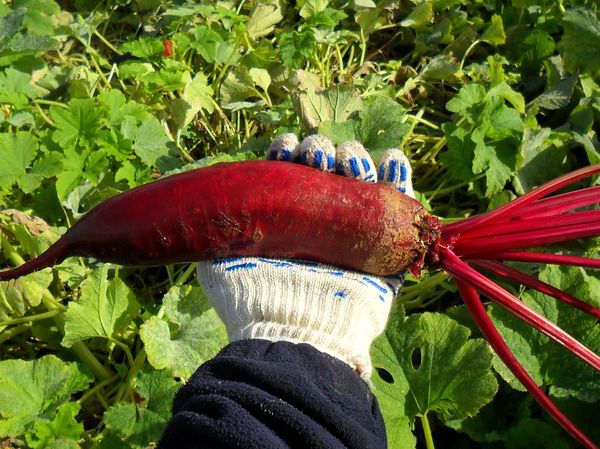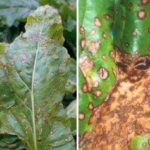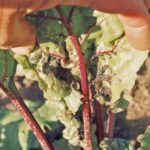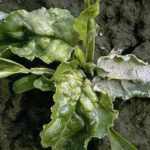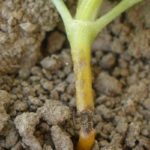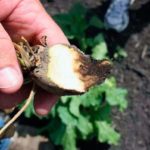Popularity in modern gardeners won a beetroot grade Cylinder. This fact is explained by the simplicity of cultivation and decent taste. The description and characteristics of this variety are discussed in this article.
Table of contents
Description and characteristics of the cylinder grade
The cylinder is a mid-season table variety. Maturing term from the moment of landing is 120 days. The roots of maroon are cylindrical in shape with thin skin. Dark red flesh without pronounced white rings, sweetish taste.Average size: length 16 cm, diameter 9 cm. Mass in the range of 250-600 g.
The shelf life of more than 4 months. Due to resistance to species diseases, the variety is high-yielding, it is 8-10 kg per 1 m2. Also contributes to this compact placement of root crops in the garden.
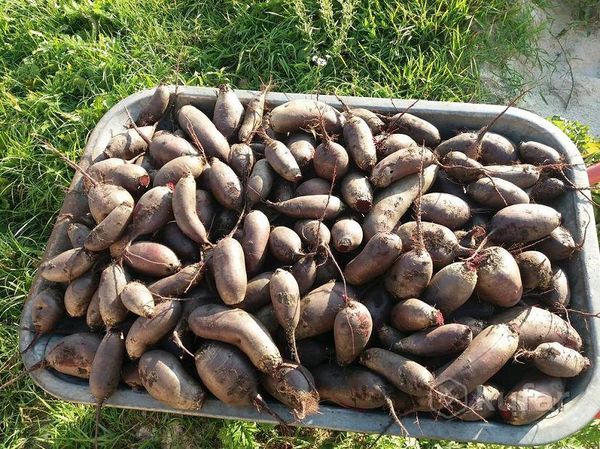
Advantages and disadvantages
The biological composition allows the use of beets for medicinal purposes. Regular use in food heals the activity of the intestines, liver, kidneys, cardiovascular system.
Variety beet Cylinder from the Dutch selection. It is cultivated throughout the territory of the Russian Federation in the open field. In the middle lane and in Siberia, a seedling method of cultivation is practiced to harvest early crops. It shortens the ripening period for fruits by 3 weeks.
The advantages of the variety include the following qualities:
- a variety of pleasant taste with a unique set of vitamins and microelements, suitable for the preparation of salads, soups, various preparations;
- has high yields with minimal care;
- during prolonged storage does not lose its properties and taste;
- saves space in the garden area, due to the elongated shape, occupies a small area;
- high marketability.
Disadvantages are not registered.
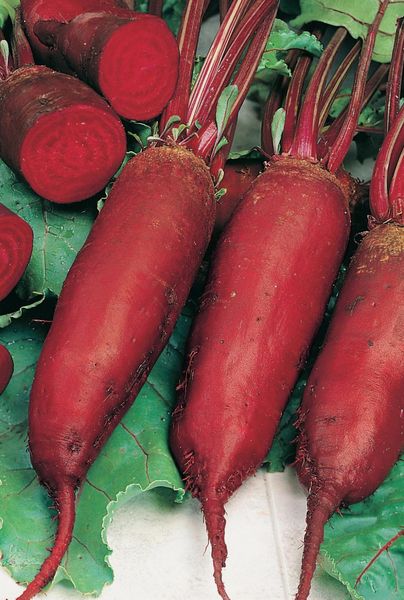
Soil preparation, planting and cultivation of beets
Growing Cylinders is done by seed and seedling methods. The latter method is more laborious and risky. Seedlings take root painfully and do not tolerate low temperatures. Seeds are selected with good germination from proven manufacturers. Work with them is necessary according to the recommendations on the bag.
Planting material is sorted by size, treated with a pink solution of potassium permanganate or infusion of ash. You can apply ready-made growth promoters Zircon or Epin. Then the washed seeds should be placed in a moist environment for swelling. Place for landing choose an open, sunny.
Root crops grow best on loose, fertile soils with an acid-base pH balance of 5 to 8, that is closer to a neutral indicator. When deviating from these indicators, fruits are often affected by diseases and poorly stored.
Observing the rule of crop rotation, beets should be planted in the garden where cucumbers, tomatoes, legumes, onions or zucchini were grown. Spinach will be a bad predecessor. You can not make in the beds fresh manure, it causes an increased level of nitrates and deformation of the fruit.
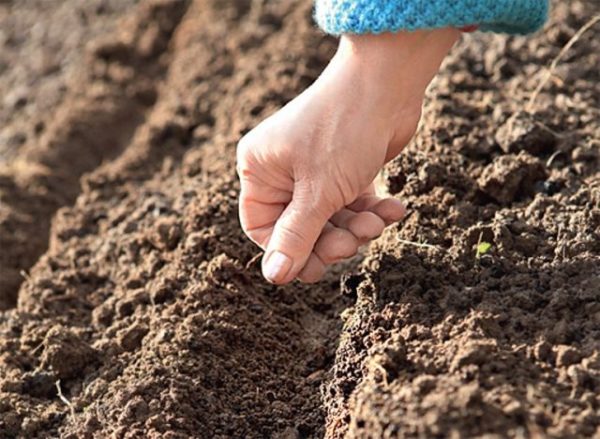
Sowing Cylinders are carried out in the second or third decade of May, at the optimum air temperature of + 12-14 degrees, and the soil is not lower than +7. The specific time of planting depends on the climatic conditions.
The sowing scheme is 25 * 6 cm with a seeding depth of 2.5-3 cm. The soil should be wet. After planting the ridge need to mulch. In warm weather, at temperatures above +20 degrees, shoots will appear on day 5. With the threat of return frosts, it will not be superfluous to take care of sheltering the beds with a spanbond.
When planting seedlings need to remember that seedlings should have tops to less than 7 cm for good survival. The main root should be slightly shortened, planted in loose moist soil, followed by watering.We are working on a cloudy day.
Care rules
The technology of growing beets involves the implementation of simple rules:
- seedlings thinned out in three stages to a final distance between them 9-10cm;
- produce systematic weeding and loosening the soil;
- dressings control the content of trace elements. At the beginning of the growing season fertilizers are applied with nitrogen. Then the most important element is potassium. Its disadvantage is better to fill with wood ash. No less important are phosphorus, magnesium and boron. Fertilizing herbal infusion gives a good result;
- watering is moderate, it is especially important during the period of seed germination and the formation of root crops. 15 days before harvesting the beet watering is practically stopped.
Experienced gardeners when watering add 1 tbsp. spoon of salt in a bucket of water to increase the sugar content and protect against pests.
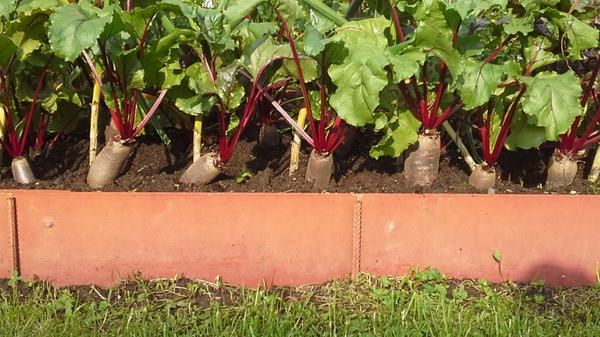
Features grade
- The main feature of the variety is the formation of a root crop above the soil surface. Havea long root crop is immersed in the ground only one third the length.
- The unique property of fast steaming distinguishes this beet. Variety Cylinder suitable for the preparation of various dishes and preservation.
- The variety has a good keeping quality, stored until the next harvest without signs of rot.
Fight against diseases and pests
Cylinder beetroot is immune to most diseases, but the necessary measures must be taken. Maximum attention should be paid to the prevention of diseases, avoiding them.
The emergence of diseases contributes to:
- heavy soil texture;
- excessive moisture;
- plant thickening;
- sprouting under frost;
- mistakes in care.
Prevention measures:
- compliance with the rules of crop rotation;
- competent preparation of seeds and beds;
- the implementation of agrotechnical rules for care.
- Beet fomoz
- Aphids on beet leaves
- Downy mildew on beets
- Beet root
- Brown beet rot
If, in spite of all the points fulfilled, painful phenomena have appeared, consider specific measures to combat them:
- Fomoz. Fungal form of the disease. Manifested by rot in the heart of the fetus, stained on the bottom sheets. The reason is a lack of boron. Apply foliar treatment with boric acid.
- Downy mildew. On the leaves of lilac-gray bloom, the leaves dry out and rot. Apply fungicides.
- Cercospora Oppressing tops, does not develop root. The reason is a lack of potassium. We carry out top dressing with ashes or potassium chloride. We follow the timely weeding.
- Corneed. Infectious disease "black leg". The reason is that the soil does not breathe, it is heavy and excessively damp. We carry out soil deoxidation with chalk, lime, loose inter-row spacing. We bring bor. We destroy diseased plants.
- Brown rot. Gray bloom on beets. The reason is an excess of nitrogen at high humidity. The cardinal control measure is the destruction of diseased plants. 2-3 years is not recommended to use this area for beets.
- Insects are pests. Beet fly and aphid, flea beetles, shield beetle. A deep digging of the ridges in the fall and regular weeding will help prevent them. Control measures - the use of insecticides of the Inta-Vir type, the use of folk methods.
Recall that an indispensable condition for a high, healthy harvest is competent care in compliance with all agrotechnical rules.
